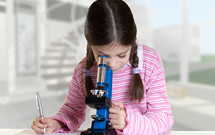 Helping middle school students grasp abstract science concepts can be a challenge. Many times, when we teach something in class, students have nothing to relate it to in the real world. So, they soon forget it.
Helping middle school students grasp abstract science concepts can be a challenge. Many times, when we teach something in class, students have nothing to relate it to in the real world. So, they soon forget it.
Five years ago, we integrated technology into our science program to help students make real-life connections to science and develop a deeper understanding of core concepts and skills. Since then, we’ve improved our science test scores by 20 percentage points and have become a Texas Education Agency (TEA) Recognized campus.
In 2006-07, when we purchased a web-based concept mastery program called Adaptive Curriculum (AC), we did something unusual. We admit it can sometimes be difficult to get teachers to buy in to new technology applications. So, we began our implementation with the students. For the first year, before teachers were trained, students used the software independently in the computer lab. The strategy was to let students explore the interactive instructional units, called Activity Objects, and report back to the teachers. Our students didn’t have to use the software; they were motivated to use it.
Students reported that the program helped them understand lessons they hadn’t understood in class. They frequently mentioned that the program’s real-world scenarios helped increase their understanding. They also found it rewarding when they were able to show their teachers how to do something in the software, and it was motivating for us to see how enthusiastic students were.
Before the second year of implementation, we teachers were trained over the summer. Our school now uses the AC Science program across all grade levels in labs, classrooms and students’ homes. We integrate the Activity Objects into whole group instruction in the classroom using SMART Boards, and often pull out sections of lessons to introduce concepts, reinforce instruction, or provide additional practice. Every student also has access in the computer lab and at home. As a result, we have found that more parents are helping students with science because they find it easier to do so now. It’s helping us create an instructional setting at home.
For students, the program’s real-world scenarios, realistic visualizations, interactive simulations, and 3-D models make abstract concepts easier to understand. Students like that they can explore, make hypotheses, manipulate items, and see the impact of their decisions. They also like that the activities are self-paced, so they can repeat something as many times as needed to ensure understanding.
For example, in a classroom lesson on solar and lunar eclipses, students were having a hard time understanding that eclipses occur when one celestial object casts a shadow on another. Hands-on demonstrations with manipulatives, like globes and flashlights, were not helping to increase their understanding. In an online lesson, however, students could manipulate a scale model of the Earth-moon-sun system to create solar and lunar eclipses, and also change the distance and angles between the objects and observe the results. Once they could manipulate the model, they got it instantly.
We teachers also like the program’s standards alignment and search capabilities, which allow us to choose lessons and activities to address our curriculum requirements and our students’ needs. With virtual labs and manipulatives, we can also teach important concepts without having to invest in expensive lab equipment or materials that could be dangerous in a traditional lab.
For example, in an online unit on the melting and boiling points of different materials, students explored the three states of matter, and examined melting and boiling points as physical properties of substances. After studying solids, liquids and gases and how to identify the changes between these states, students conducted experiments and graphed heating curves of various substances, such as sulfur. In a traditional lab setting, we would not have been able to conduct this experiment because sulfur, when boiled, becomes toxic.
We have also found that integrating technology into science has helped us to become facilitators of student learning. We now spend more time as the “guide on the side” rather than the “sage on the stage.” In addition, we can use data from online assessments to re-teach or adjust our instruction if we see students struggling with a concept.
By using real-world connections to develop students’ conceptual understanding, rather than learning by rote, we have motivated students to take an active role in their learning. As a result, our students are better able to master the Texas Essential Knowledge and Skills (TEKS) for Science.
Now, when students get to our state test, they have an image in their minds — something they can remember and relate the questions to. And that is reflected in our test scores. Over the last few years, our science scores have gone up an average of six or seven points a year. In 2011, our science scores were the highest we’ve ever achieved. Eighty-one percent of students met the standard in science, up from 61 percent in 2008. As a result of our success, we have decided to increase our use of this approach in math as well.
By helping students make real-life connections between themselves and the science concepts in their environments, we are taking conceptual development to a higher level and helping students develop knowledge and skills that will last a lifetime.
Noe Granado and Seth R. Hawkins are teachers at Besteiro Middle School in Brownsville, Texas.
- 4 ways to encourage play in education - April 25, 2024
- CoSN IT Leader Spotlight: Lisa Higgins - April 25, 2024
- It’s time to pay student teachers - April 25, 2024
